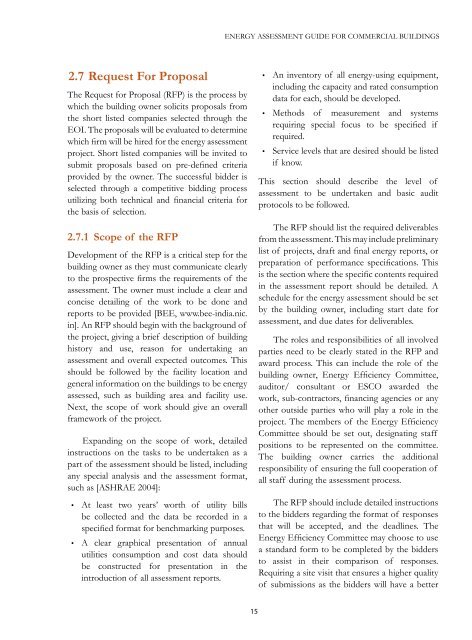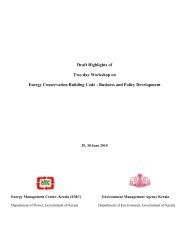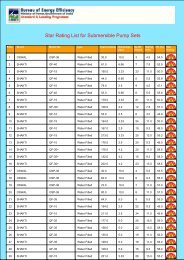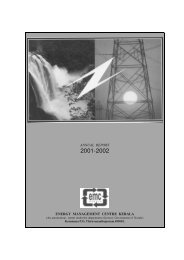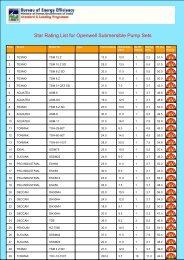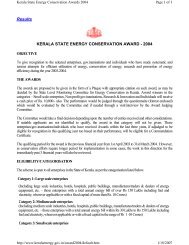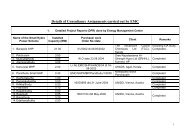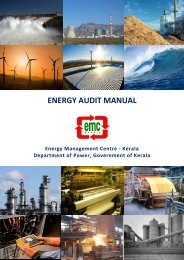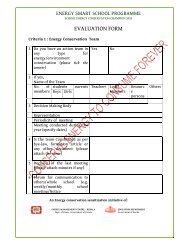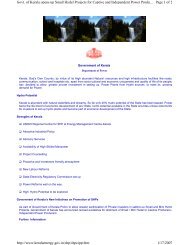energy assessment guide for commercial buildings - ECO-III
energy assessment guide for commercial buildings - ECO-III
energy assessment guide for commercial buildings - ECO-III
You also want an ePaper? Increase the reach of your titles
YUMPU automatically turns print PDFs into web optimized ePapers that Google loves.
ENERGY ASSESSMENT GUIDE FOR COMMERCIAL BUILDINGS<br />
2.7 Request For Proposal<br />
The Request <strong>for</strong> Proposal (RFP) is the process by<br />
which the building owner solicits proposals from<br />
the short listed companies selected through the<br />
EOI. The proposals will be evaluated to determine<br />
which firm will be hired <strong>for</strong> the <strong>energy</strong> <strong>assessment</strong><br />
project. Short listed companies will be invited to<br />
submit proposals based on pre-defined criteria<br />
provided by the owner. The successful bidder is<br />
selected through a competitive bidding process<br />
utilizing both technical and financial criteria <strong>for</strong><br />
the basis of selection.<br />
2.7.1<br />
Scope of the RFP<br />
Development of the RFP is a critical step <strong>for</strong> the<br />
building owner as they must communicate clearly<br />
to the prospective firms the requirements of the<br />
<strong>assessment</strong>. The owner must include a clear and<br />
concise detailing of the work to be done and<br />
reports to be provided [BEE, www.bee-india.nic.<br />
in]. An RFP should begin with the background of<br />
the project, giving a brief description of building<br />
history and use, reason <strong>for</strong> undertaking an<br />
<strong>assessment</strong> and overall expected outcomes. This<br />
should be followed by the facility location and<br />
general in<strong>for</strong>mation on the <strong>buildings</strong> to be <strong>energy</strong><br />
assessed, such as building area and facility use.<br />
Next, the scope of work should give an overall<br />
framework of the project.<br />
Expanding on the scope of work, detailed<br />
instructions on the tasks to be undertaken as a<br />
part of the <strong>assessment</strong> should be listed, including<br />
any special analysis and the <strong>assessment</strong> <strong>for</strong>mat,<br />
such as [ASHRAE 2004]:<br />
•• At least two years’ worth of utility bills<br />
be collected and the data be recorded in a<br />
specified <strong>for</strong>mat <strong>for</strong> benchmarking purposes.<br />
•• A clear graphical presentation of annual<br />
utilities consumption and cost data should<br />
be constructed <strong>for</strong> presentation in the<br />
introduction of all <strong>assessment</strong> reports.<br />
•• An inventory of all <strong>energy</strong>-using equipment,<br />
including the capacity and rated consumption<br />
data <strong>for</strong> each, should be developed.<br />
•• Methods of measurement and systems<br />
requiring special focus to be specified if<br />
required.<br />
•• Service levels that are desired should be listed<br />
if know.<br />
This section should describe the level of<br />
<strong>assessment</strong> to be undertaken and basic audit<br />
protocols to be followed.<br />
The RFP should list the required deliverables<br />
from the <strong>assessment</strong>. This may include preliminary<br />
list of projects, draft and final <strong>energy</strong> reports, or<br />
preparation of per<strong>for</strong>mance specifications. This<br />
is the section where the specific contents required<br />
in the <strong>assessment</strong> report should be detailed. A<br />
schedule <strong>for</strong> the <strong>energy</strong> <strong>assessment</strong> should be set<br />
by the building owner, including start date <strong>for</strong><br />
<strong>assessment</strong>, and due dates <strong>for</strong> deliverables.<br />
The roles and responsibilities of all involved<br />
parties need to be clearly stated in the RFP and<br />
award process. This can include the role of the<br />
building owner, Energy Efficiency Committee,<br />
auditor/ consultant or ESCO awarded the<br />
work, sub-contractors, financing agencies or any<br />
other outside parties who will play a role in the<br />
project. The members of the Energy Efficiency<br />
Committee should be set out, designating staff<br />
positions to be represented on the committee.<br />
The building owner carries the additional<br />
responsibility of ensuring the full cooperation of<br />
all staff during the <strong>assessment</strong> process.<br />
The RFP should include detailed instructions<br />
to the bidders regarding the <strong>for</strong>mat of responses<br />
that will be accepted, and the deadlines. The<br />
Energy Efficiency Committee may choose to use<br />
a standard <strong>for</strong>m to be completed by the bidders<br />
to assist in their comparison of responses.<br />
Requiring a site visit that ensures a higher quality<br />
of submissions as the bidders will have a better<br />
15


